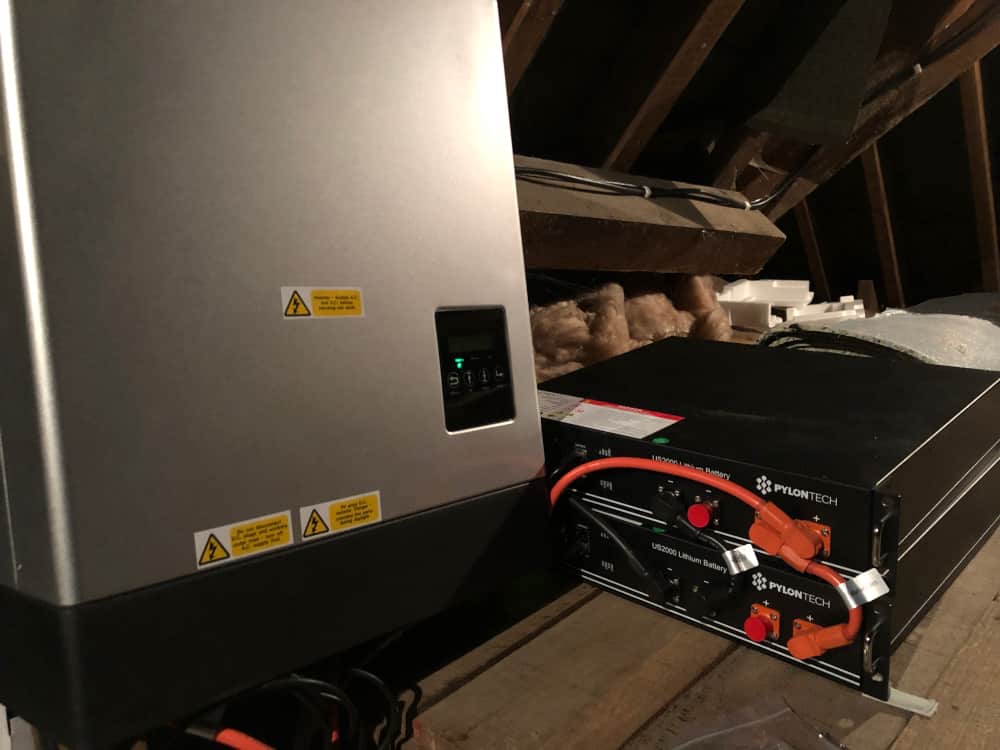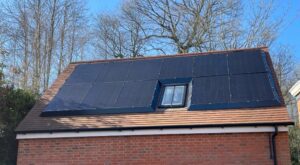It was one year ago that we decided to add solar panels to our roof
The main reasons were:
- Reduce our monthly electricity
- Help with reducing our carbon footprint
With two Electric cars, at the time a Nissan Lean and Mitsubishi Outlander, we use a considerable amount of electricity but not much petrol, so already we were a reasonable way down the less CO2 road.
Having an EV you learn about the basics of electric power, charge rates and kilowatt-hours or KWh.
For example the LEAF has a 24 KWh battery pack, and a full pack is good for around 100 miles. Very basic maths gives the LEAF a power usage of close to 4 miles per KWh. (100miles / 24 KWh).
Power companies also use KWh as the base charge unit for billing consumers. If you look at you bill you will see a rate of say 18p per kWh. According to the Department for Business, the average cost for standard electricity in the UK in 2020 was 17.2p/kWh.
That rate would give the LEAF a cost of 17.2 * 24 to drive 100 miles. Or around 4p pe rmile.
So what exactly is a kilowatt hour?
A kilowatt hour (kWh) is a measure of how much energy you’re using.
It doesn’t mean the number of kilowatts you’re using per hour. It is simply a unit of measurement that equals the amount of energy you would use if you kept a 1,000 watt appliance running for an hour:
So if you switched on a 100 watt light bulb, it would take 10 hours to rack up 1 kWh of energy.
Or a 2,000 watt appliance would use 1 kWh in just half an hour.
While a 50 watt item could stay on for 20 hours before it used 1 kWh.
A quick note on power compared to energy
The standard unit of electrical power is the watt, which is defined as a current of one ampere, at a voltage of one volt. More simply, volts x amps = watts. In the UK, the standard wall socket delivers 240 volts. If you plug in an old school light bulb and find that a current of 1/4 amp is flowing through it, you know that the power used by the bulb is (240) x (1/4), or 60 watts.
So much for power. How much energy is the bulb using? That depends on how long we leave it burning. A 60-watt bulb burning for one hour will consume 60 watt-hours of energy. Ten bulbs burning for ten hours would consume 10 x 60 x 10, or 6,000 watt-hours, which we can write more conveniently as 6 kWh. A thousand households all doing this would consume 6,000 kWh, which equals 6 megawatt-hours, or 6 MWh (since 1,000,000 watts = 1,000 kilowatts = 1 megawatt).
Energy is the total amount of work done, and power is how fast you can do it. In other words, power is energy per unit of time. Power is watts. Energy is watt-hours.
Enough of the science
In March 2020 we installed 9 solar panels an inverter and 2 battery packs. Lets looks at each item in turn.
Panels: JA Solar black
The solar panels attach to the roof and convert solar light into electrical energy. Simply put the more sun the more power. Each panel is rated at 310 W. This is the maximum theoretical power that the panel will produce. In the UK this basically never happens. We are a long way from the equator, we have clouds and rainy days. More importantly our panels are fixed to the roof and point close to South at around 35 degrees elevation. The suns path around the house varies considerably between June and December. The panels get some afternoon shade by parts of the roof and chimney pots.
Or in other words they only generate electricity for part of the day and that time changes with the season and the power output is also determined by the strength of the daylight.
Inverter – LuxPower Hybrid Inverter
The inverter is the most important part of the system. Is controls all aspects of power generation and use. Your power comes from the grid as 240 Volts AC. The panels generate DC current that varies with the solar power. The inverter converts the DC solar into AC power that can power the house or be directed back into the Grid as well as connecting up the Battery packs that uses 48 Volt DC.
The inverter is the glue and it needs to be configurable to match your needs with its capabilities.
The LuxPower has a WI -Fi connection and can be access via a web browser, more of this later.
Battery Pack: PylonTech Battery Storage
Our system was configured with two battery units each with 2.4kWh storage giving 4.8KWh of maximum stored capacity.
Octopus – The clever bit
Initially our Electricity was provided by Scottish Power. Asking them to convert to Eco 7 configuration to power the LEAF at cheaper night rate was proving impossible. At the time Scottish Power had little if any concept of Eco7 and ‘smart’ meters. They spend 6 months trying to configure a Type 1 Smart meter to Eco 7. Eventually deciding it was impossible.
We then switched to Octopus energy as they seemed to understand Smart meters and were more than happy to install a 2nd generation smart meter that provided night rates.
Octopus Go
After moving to Octopus Energy we moved to the then Beta version of Octopus Go and this is the killer app for solar and battery power.
With Octopus Go we receive low cost power between 00:30 and 04:30 every day. This is when most consumers have very little use for Electricity unless you have a car to charge or a battery to fill.
The goal of our Solar project was to charge the car and fill the battery storage at the low cost and power the house on batteries until the solar was generating enough to power the house and then replenish the battery power with excess solar energy. Then as the sun sets in the West, hopefully the battery pack would have enough juice to power the house for the rest of the evening.
If you can cast your mind back to May 2020 – or the sunny days of lockdown #1 you may recall basking in sunshine for day upon day. It tuned out that April and May were incredibly sunny.
The LuxPower log shows daily and monthly power.

The panels generated 265 KWH in April and 300 KWh in May 2020. – Numbers that were not repeated in the true summer of June – August.
The sun’s power was filling the battery packs and powering the house and the excess power was export to the grid. With Octopus Go exported power has no value, you are not paid for generation.
A number of years ago the Government offered the RHI – a feed in scheme that did pay you for generation with a reasonably generous feed in tariff but those days are long passed.
With the 4.8 KWh pack we had enough power to run the house until lunch time on a cloudy day. On a sunny day the rate of battery usage slows and extend the off grid hours.
As an example the house uses around, 450 W at night and 950 w during the day time, with surges for the kettle, toaster and oven. The batteries take over powering the house at 04:30 and for the first 3 hours use around 1KWH. Then from 07:30 the power usage ramps to close to 1000W. The pack total of 4.8 WKh is depleted by around 10 AM with no sun. With sun the rate of discharge slows. A moderate day in the Spring might add 500W of power. While a sunny day may generate 2,500 W for a few hours. Both these examples extend the battery pack life to power the house to 2PM or maybe 4PM in the Summer.
We decided to increase the battery pack size to increase our storage capacity: This enabled us to take more power at the night rate and also give more scope to store more of the solar energy rather than export or waste it. Over the next few months we added two additional PylonTech Batteries, each another 2.4Kwh and so bringing the total storage to 9.6Kwh.
This extra storage increases the length of time that we can run on the battery packs rather than the grid.
The maths. Or KWh Pricing.
The Octopus rate is 5p off peak and 15p per KWH the rest of the time. This means that by filling the battery with off peak electricity we pay 5p and can consume that energy later in the day when the grid power is 15p. The larger the battery the greater the saving, Of course if you add in solar power – this is free energy but in effect worth 15p per KWH.


This chart cover 24 hours on March 19th this year. It shows at 00:30 with the red line we are taking around 5Kw of power from the grid. This fills the car battery pack and the PylonTech batteries. As the car and packs fill the power drops to 2.5kW and then at 04:30 the Grid power falls to 0w and the battery packs take over as show b the Blue line. For the next few hours the demand is 750W or so and then at around 9:30 the solar production ramps up and grows to around 2500W between 11:45 and 14:15 with a few cloud interruptions. During the sun shine power is few back into the batteries – The blue line. The power is in effect the area under the graph. The Blue line is around 1500W for 3 hours – or around 4.5KWH. The battery pack then powers the house unit they run empty just before 20:00.
Every day the results are slight different as the solar output varies with the year and conditions. The consumption is relatively constant, Slightly more in winter as more lights are used and the underfloor heading has a bigger battle.
Results for the year:
The Lux inverter says for 2020 we generated 1590 KWH from the Sun, Consumed 8300 KWH and the battery provided 2600 KWH.
So far in 2021 another 170WKh has come from the Winter sun.
Apparently in total this equates to a saving of 715 KG of coal burning and a saving of 1.8 Tons of CO2.
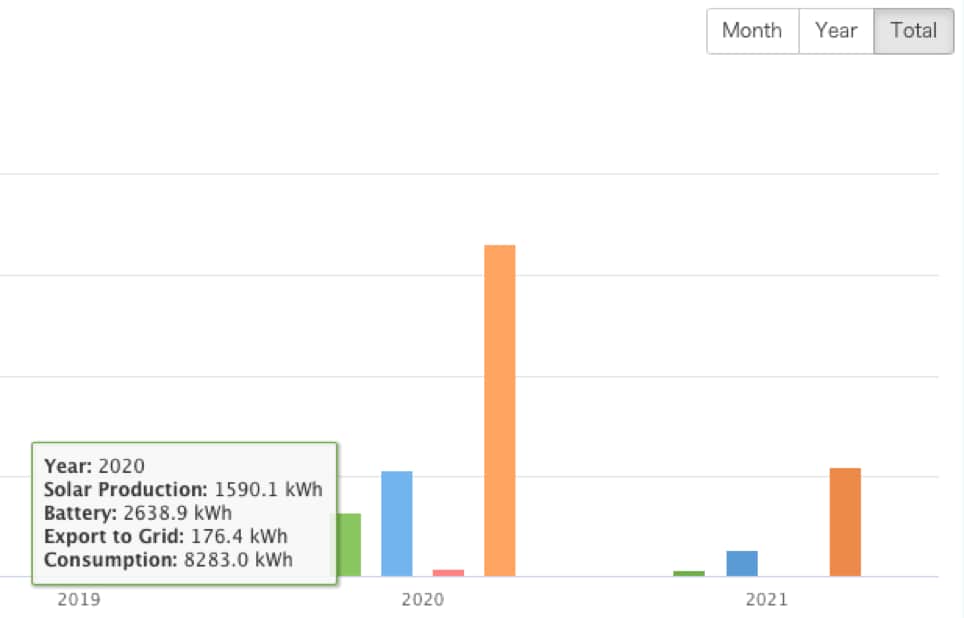

Sources:
Solar installation:
Contract Solar. https://www.contact-solar.co.uk
Solar Panels:
JA Solar. JA are a Chinese company that has grown at a huge rate and now one of the largest producers of panels. See https://www.jasolar.com.cn/html/en/en_pv/


The website is not very informative and the products are hard to understand.
The key aspects of any solar panel is the efficiency measurement. How much power does the panel produce for a unit of sun shine. Panels are continuing to improve in efficiency and as the volumes skyrocket the prices fall.
We selected the all black panels rather than the more common silver edge units as they look visually much neater or more aesthetically pleasing, important in an area of AONB.
- Rating: 305 W
- Efficiency: 18.7 %
- Width: 991 mm
- Height: 1,678 mm
We have 9 of these that would give a maximum output of 9 * 305 W or 2745W.
They seem a fine unit. They were recommended by Contact Solar and were the only all black units offered.
Inverter:
This is the most important bit of kit. At the time of purchase we did not understand fully how import this is. Again Contact Solar offered the Lux Hybrid inverter and a little bit of research showed it to a reasonable product.
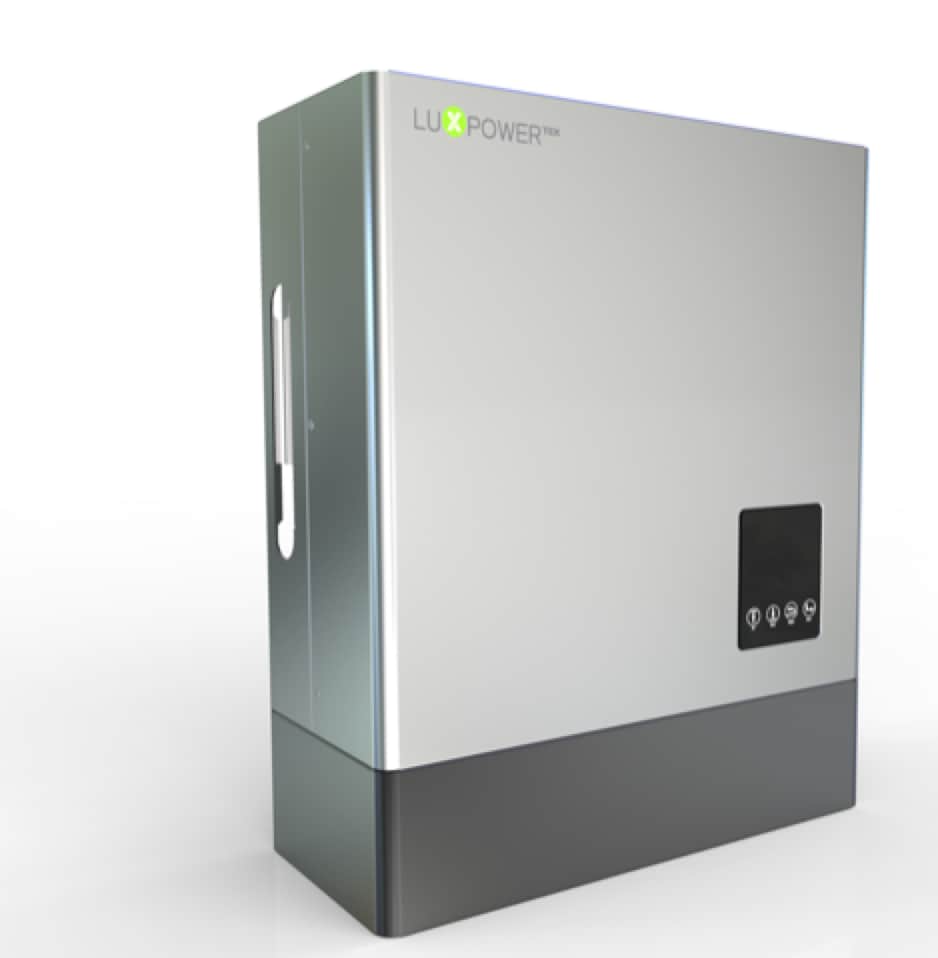

Lux is another Chinese firm growing like crazy as the world moves to solar.
Read more at https://www.luxpowertek.com/hybrid-hb.html
The key part is how you control the Inverter and how you monitor the system.
Again at the time of purchase we knew none of this. However the Lux seems rather good.
They have an iOS and Android apps and a browser interface. each inverter has a Wi-Fi connection that requires initial set up with a PC connected to the unit. Once configured it has proved highly reliable.
You can see all aspects of the unit – there is plenty of data on voltage, current and activity.
The setup and configuration is all down via the app or browser. This is where you can see the charge times and rates.


Here you can see the Inverter start charging for the AC grid at 00:30 and charges at 85% rate to 97% level.
There are plenty of other data points available: This shows at the top right the battery charge. It starts at 10% and ramps up as it charges from the grid, until it is close to 100% at 04:30 and the reduces as the house consumes energy.


As the sun adds charge the graph is more like this: Where the charge level increases from 50 to 75% between 12:00 and 16:00.
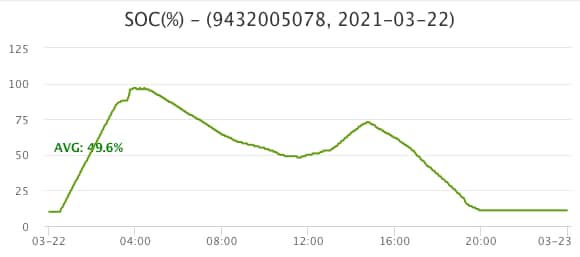

Battery Pack:
PylonTech. See http://en.pylontech.com.cn/?lan=en
Another Chinese company producing huge volumes of batteries. They claim more than 3 GWH of battery capacity.


Again we had no idea if these were good or not and took advice from Contact Solar. So far they seem a good choice. They sit in the loft linked to the Inverter and do their job.
Each unit is rated at 2.4KWh and offers 90% DoD over 6,000 cycles, Thats means that after 6000 charge cycles the battery will still provide 90% of the rated 2.4KWh of storage. If you change daily then 6,0000 cycles is close to 16 years of operation. They offer a 10 year warranty.
We started with a pair of batteries for 4.8KWh storage.


In April added a third unit and in July a 4th battery to give 9.6KWh of storage.


Adding a fifth in March 2021 to bring up capacity to 12KWh.
Power Supply Company:
We switched from Scottish Power to Octopus and never looked back.
With solar, batteries or an EV Octopus has the best offering on the market and has the attitude and focus to provide you with hope that they as a provider understand the needs of the modern homeowner. They are more of a software company and know what an API this.
With the Octopus Go rate we are billed at 4.76/ KWh at the night rate 00:30 to 04:30 and the day rate of 13.71 p/ KWh.
Every month the bill shows consumption per day per half hour and total usage and provides an average cost per kWh for the month.
In Jan 21, a month with little solar we used 1042 KWh of energy split nearly 50/50 with 500 units at night and 550 during the day. – Giving an average rate of 9.48p / KWh.
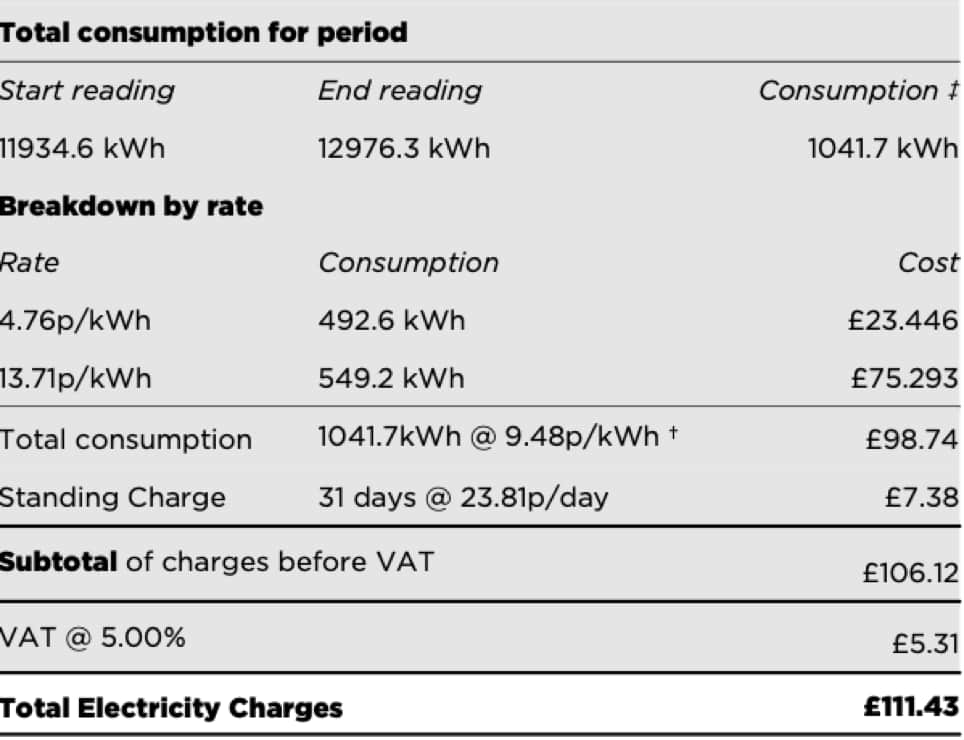

To switch to Octopus you can use our referral code to save £50. See share.octopus.energy/aglow-foal-953
Data from Octopus:
On the web portal you can see daily consumption.
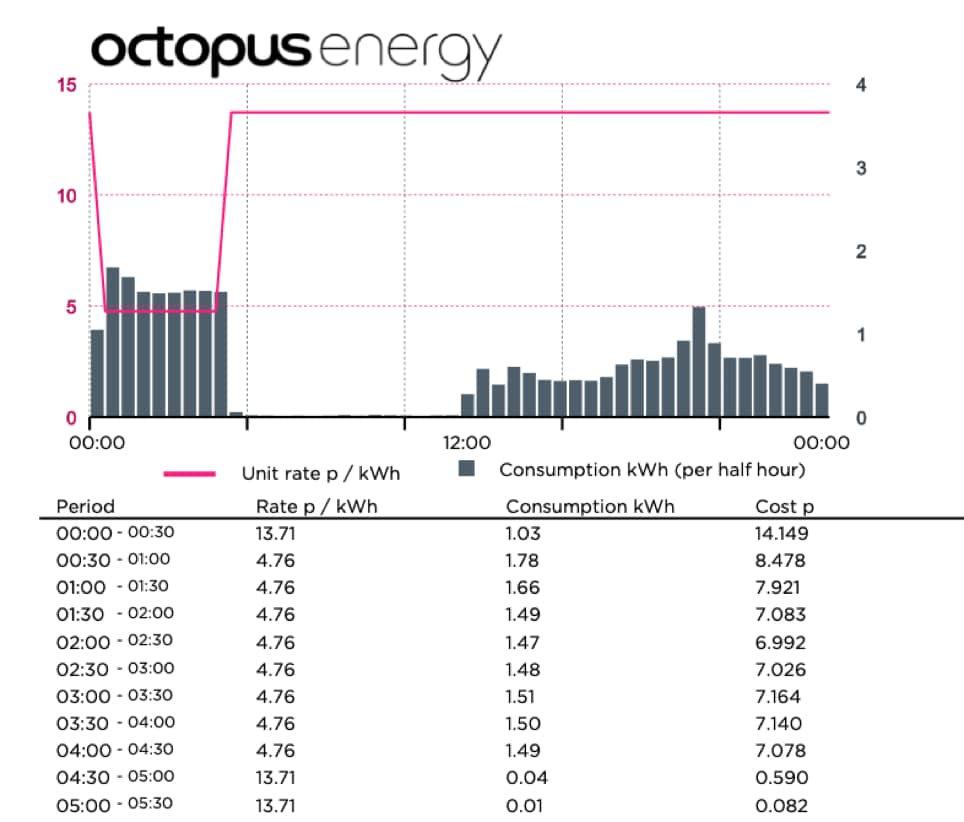

And on the bill the same date:
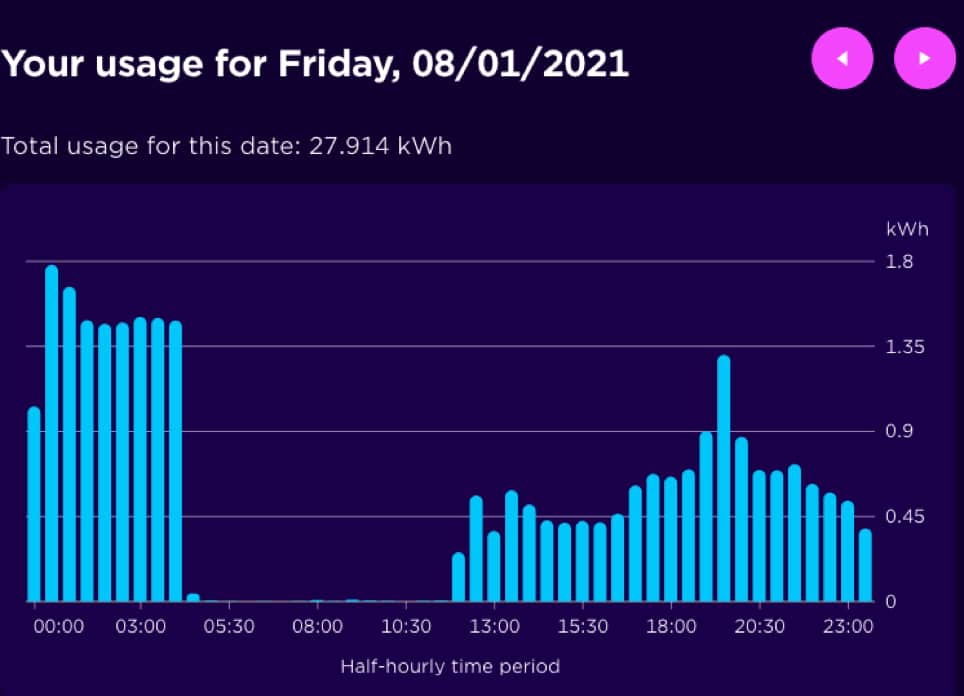

Using January as the typical month we used:
1050 KWh and paid an average of 9.5 p / KWh.
Assuming that is valid for a year we would have total usage of 12 * 1050 or 16,600 KWh at 9.5p that’s £1200. In fact January is the worst month as the usage is higher and the solar is tiny.
If we had paid the UK average of 17p that would have been £2800.
In the first year the sun generated around 1760 KWh. Using the off peak rate of 14p that is worth an additional £250.
As we move into the Spring and Summer with over 10KWh of battery we expect our nigh rate usage to increase and the day rate to reduce my more as the sun starts to increase its contribution. As we do this the average monthly unit cost will drift down towards the 4.7p / KWh rate.
Summary:
The 9 solar panels generated 1760 KWh with a value of £250.
The battery packs delivered 3330 Kwh of power over the 12 months. We started with two and ended the year with four battery units. Assuming these were charged at 4.7p and delivered the power to the house when power costs 15p that is worth 10p / KWH or an additional £330. This is not entirely true as some of the solar power is used in these calculations so we have a bit of double bookkeeping. If we can this 10% then we have a net saving of £300.
Adding solar and battery wa have a annual saving of around £550. The total cost of the installation was around £7500. Or payback in 13 years at current electricity prices. Any price increase in the electric rate reduces the payback time. With interest rates low leaving £7500 in any bank generates a fine sum of £20 per year.
Tesla added:
Since the project started the LEAF has been replaced with a Model 3 Tesla. The Tesla has 3 times the battery of the LEAF and is marginally more efficient. The Model 3 has a range of 310 miles, three times the LEAF. In terms of charging it will use roughly the same amount of energy / cost as the LEAF but rather than charge daily it may require a weekly charge, depending on usage. Tesla also provide Superchargers for road trip charging. At these you can charge at around 150 Kw/h and pay Tesla a rate of around 28p / KWh. So more than home charging but the time to charge is 20 mins rather than 8 hours.
If you are looking to add a Tesla you can use our referral code to add 1,000 miles of supercharging: See tesla

